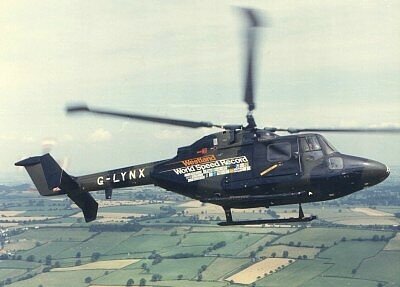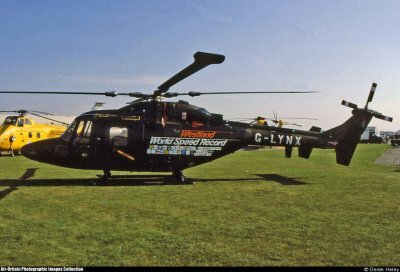 |
In January 2010 The Museum's Westland Lynx AH.1, G-LYNX, was chosen to be one of ten contributions from the County of Somerset, for the BBC project "A History of The World".
Originally built by Westland, in Yeovil, as a company demonstrator, G-LYNX, c/n 102, first flew in May 1979. It appeared at Farnborough Air Show in 1980 and was later sent to Rolls-Royce for trials before returning to Yeovil. Westland then decided to use it in an attempt to beat the existing World Speed Record for a Helicopter, then held by a heavily modified Russian Mil Mi-24 'Hind' which had attained a speed of 228.9mph in September 1978. By aiming to better this, Westland was not only looking for prestige but also a useful marketing tool that could be used to boost sales of the Lynx. In 1985 Westland engineer teams set to work upgrading G-LYNX for the attempt. |
|
 |
||
| G-LYNX at RAF Finningley on 20th September 1986 Photograph by Derek Heley www.abpic.co.uk |
||
|
In its modified form, G-LYNX took to the air from Yeovil on 11th August 1986 with Westland's Chief Test Pilot, Trevor Egginton, at the controls and Flight Test Engineer Derek Clews alongside. Flying a 9.3 mile course over the Somerset Levels, G-LYNX reached 249.09mph, smashing the 'Hind's' best figure to set up a new Class E (Rotorcraft) Absolute World Speed Record that remains unbroken to this day. The effort brought some much-needed publicity for Westland and led to many of the improvements, which had been made to G-LYNX, being adopted for use on later production Lynx. |
||
| G-LYNX was further modified subsequently and used, in 1991, for trial installation of the American LHTEC CTS-800 engines for a potential Middle East sale. It was retired in 1992 and, in 1995, was loaned to The Helicopter Museum, in Weston-super-Mare (right), with full ownership being transferred in 2000. In 2003 G-LYNX was one of The Museum's contributions to RIAT's "100 Years of Flight" celebration at Fairford. On 13th October 2007 G-LYNX was transported to Yeovil for restoration, by the AgustaWestland apprentices, to its 1986 configuration and colour scheme before returning to The Museum in July 2011 for the 25th Anniversary of the record-breaking flight. |  |
|
| G-LYNX at RNAS Yeovilton in July 2011 following a four year restoration, by AgustaWestland Yeovil apprentices, to its 1986 record-breaking configuration and colour scheme. It was unveiled to the Yeovil workforce before being transported to RNAS Yeovilton for static display at Yeovilton Air Day on 9th July 2011. Five days later it was returned to The Helicopter Museum to celebrate the 25th anniversary of its epic flight and to be retained for permanent display. Thanks to Rod Holloway for this photo. | ||